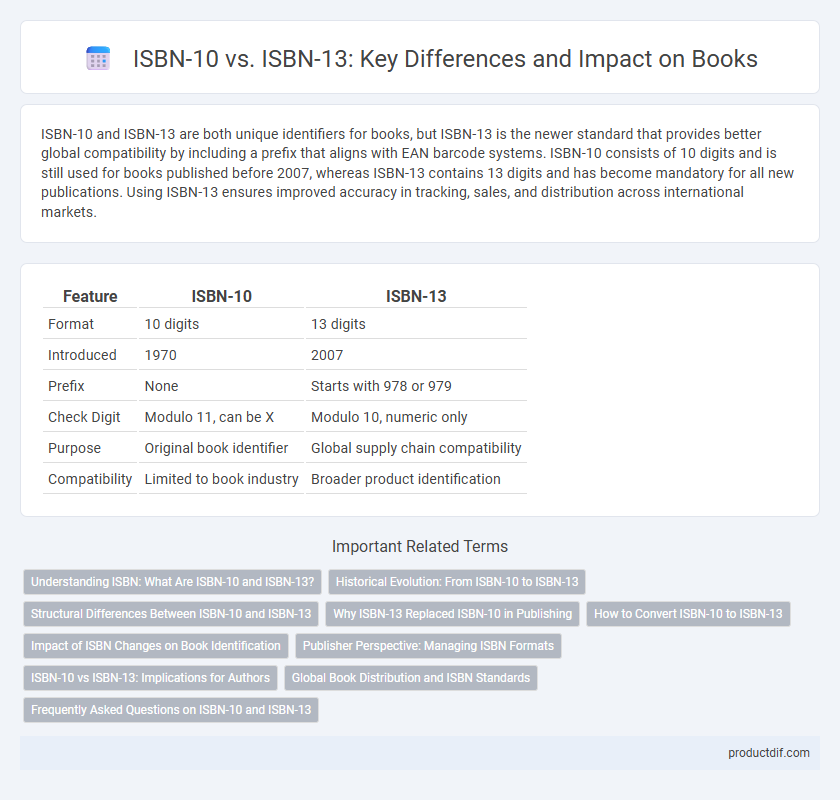ISBN-10 and ISBN-13 are both unique identifiers for books, but ISBN-13 is the newer standard that provides better global compatibility by including a prefix that aligns with EAN barcode systems. ISBN-10 consists of 10 digits and is still used for books published before 2007, whereas ISBN-13 contains 13 digits and has become mandatory for all new publications. Using ISBN-13 ensures improved accuracy in tracking, sales, and distribution across international markets.
Table of Comparison
| Feature | ISBN-10 | ISBN-13 |
|---|---|---|
| Format | 10 digits | 13 digits |
| Introduced | 1970 | 2007 |
| Prefix | None | Starts with 978 or 979 |
| Check Digit | Modulo 11, can be X | Modulo 10, numeric only |
| Purpose | Original book identifier | Global supply chain compatibility |
| Compatibility | Limited to book industry | Broader product identification |
Understanding ISBN: What Are ISBN-10 and ISBN-13?
ISBN-10 consists of 10 characters used for identifying books, mostly before 2007, while ISBN-13 has 13 digits and is the current standard for book identification worldwide. ISBN-13 starts with a 978 or 979 prefix, which aligns it with the global EAN barcode system, improving compatibility in international markets. Understanding the differences between ISBN-10 and ISBN-13 is crucial for publishers, booksellers, and libraries for accurate cataloging and inventory management.
Historical Evolution: From ISBN-10 to ISBN-13
ISBN-10, introduced in 1970, provided a 10-digit unique identifier for books but faced limitations with the growing inventory and international standardization. The transition to ISBN-13 in 2007 aligned the book numbering system with the global EAN barcode format, expanding the numbering capacity and improving compatibility with international supply chains. This evolution addressed the need for a more scalable and universally recognized system, facilitating better tracking and distribution within the global book market.
Structural Differences Between ISBN-10 and ISBN-13
ISBN-10 consists of 10 digits, including a group identifier, publisher code, title identifier, and a single checksum digit, designed primarily for books published before 2007. ISBN-13 expands this format to 13 digits by adding a 3-digit prefix (usually 978 or 979) before the core elements, aligning book identification with the EAN-13 barcode standard. The ISBN-13 uses a different checksum calculation method based on modulo 10 with alternating weights of 1 and 3, improving error detection compared to the ISBN-10's modulo 11 system.
Why ISBN-13 Replaced ISBN-10 in Publishing
ISBN-13 replaced ISBN-10 in publishing to address the limitations of the 10-digit format, specifically to expand the capacity for unique book identifiers in the growing global market. The 13-digit ISBN format aligns with the EAN-13 barcode standard, facilitating easier integration with international retail and inventory systems. This transition ensures greater compatibility and scalability for book identification worldwide, accommodating the surge in published works and global distribution demands.
How to Convert ISBN-10 to ISBN-13
To convert an ISBN-10 to ISBN-13, first prepend the prefix "978" to the ISBN-10 without its check digit. Then calculate the new ISBN-13 check digit using the weighted sum formula, where digits in odd positions are multiplied by 1 and even positions by 3, and the total sum is used to find the remainder when divided by 10. Subtracting this remainder from 10 yields the final check digit, completing the 13-digit ISBN.
Impact of ISBN Changes on Book Identification
ISBN-10 and ISBN-13 are unique identifiers for books, with ISBN-13 offering enhanced compatibility with international barcode standards and digital databases. The transition from ISBN-10 to ISBN-13 improved book identification accuracy by expanding the numeric system from 10 to 13 digits, reducing duplication and increasing global traceability. Publishers, bookstores, and libraries rely on ISBN-13 to ensure precise inventory management and streamlined distribution in the global book market.
Publisher Perspective: Managing ISBN Formats
Publishers must efficiently manage both ISBN-10 and ISBN-13 formats to ensure accurate cataloging and seamless distribution across global markets. ISBN-13, now the standard, supports improved compatibility with digital systems and international book databases, while ISBN-10 remains relevant for legacy titles requiring conversion and verification. Effective ISBN management software aids publishers in tracking and validating both formats, enhancing inventory control and sales reporting precision.
ISBN-10 vs ISBN-13: Implications for Authors
ISBN-10 and ISBN-13 are unique identifiers crucial for authors to manage book sales and distribution globally; ISBN-13 expands the numbering system to accommodate more titles and enables compatibility with international barcode standards. Authors must update or acquire ISBN-13 for new editions to ensure libraries, retailers, and online platforms recognize and catalog their work correctly. Transitioning from ISBN-10 to ISBN-13 impacts metadata management, pricing accuracy, and global market reach, making the understanding of both formats essential for effective book marketing and rights management.
Global Book Distribution and ISBN Standards
ISBN-13 enhances global book distribution by aligning with the EAN-13 barcode system, enabling seamless scanning and inventory management across international markets. Unlike ISBN-10, which was limited to national scope, ISBN-13 includes a 3-digit prefix that standardizes identifiers worldwide, facilitating broader accessibility and efficient tracking. Compliance with ISBN-13 standards ensures publishers meet global industry requirements, optimizing supply chain operations and cross-border book sales.
Frequently Asked Questions on ISBN-10 and ISBN-13
ISBN-10 consists of 10 digits and was the standard format for identifying books before January 2007, while ISBN-13 contains 13 digits and is the current standard compatible with the EAN barcode system. Frequently asked questions about ISBN-10 and ISBN-13 often address their format differences, conversion methods, and why ISBN-13 offers better global compatibility and tracking. Publishers and booksellers prioritize ISBN-13 for new publications due to its universal acceptance in digital and physical distribution channels.
ISBN-10 vs ISBN-13 Infographic

 productdif.com
productdif.com